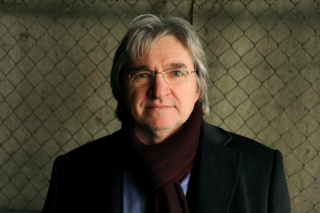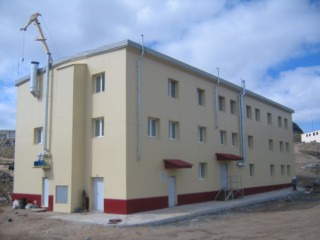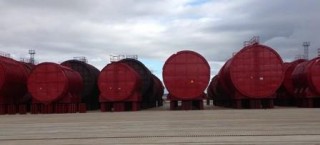
The system built to manage Russia’s nuclear legacy is crumbling, our new report shows
Our op-ed originally appeared in The Moscow Times. For more than three decades, Russia has been burdened with the remains of the Soviet ...
News

Publish date: February 21, 2015
News
Some 23,000 spent nuclear fuel rods from submarines and 32 tons of radioactive waste housed at Andreyeva Bay, 50 kilometers from the Norwegian border, may soon become a hot issue if additional funding to remove it from the site not found, Alexander Nikitin, chairman of the Environment and Rights (ERC) Bellona said.
Nikitin, a former nuclear submarine captain and naval nuclear safety inspector, coauthored a report on international nuclear remediation efforts in Northwest Russia with Alexei Shchukin, ERC Bellona’s nuclear projects coordinator.
The report was published in Russian in November, and its newly-completed translation into English is available here.
It concludes that $20 billion in nuclear remediation aid to Russia’s Northwest financed by G-8 nations and the European Bank of Reconstruction and Development under their Global Partnership fund have largely been carried out.
But Nikitin said that critical work to rid Northwest Russia’ most dangerous nuclear legacy hazard of 40-years of accumulated spent nuclear fuel and radioactive waste could falter if another $1.5 billion dollars is not injected into the cleanup project.

The Global Partnership efforts were, notes the report, “projects of [a] nature [and] scope [that have never] been attempted before” anywhere in the world. This meant that, “emphasis was placed on achieving maximum safety rather than speed of implementation,” the report reads.
Further funding agreements needed
In an interview, Nikitin said the 10 year’s worth of funding from the United States and European nations incurred cost overruns resulting in a shortfall of about $1.3 billion for Andreyeva Bay to transport its spent nuclear fuel and radioactive waste offsite.
The fuel and waste are supposed to be sent to the Mayak Chemical Combine in the Southern Urals for possible reprocessing.
Nikitin further said the EBRD and a number of donor nations such as Sweden, France and Russia itself are unwilling to sign further joint nuclear remediation contracts now that the decade-long Global Partnership, which ended in 2012, has run its course.
Nikitin said new plans for the future disposition of Andreyeva Bay envision the waste and spent nuclear fuel will start its journey to Mayak by the summer of 2016, if the funding can be secured. But even this planned departure date is a year behind schedule, he said.

Russian and Norway in search of other partners
Moving the waste is of particular concern to the Norwegian Radiation Protection Authority (NRPA), as Norway is the only country involved in the earlier efforts that stands ready to continue cooperation with Russia to completely rid Andreyeva Bay of its radioactive holdings.
The NRPA has said it is concerned about possible accidents at Andreyeva Bay, the Norwegian daily Aftenposten reported.
But Norway is also wary of being the only nation financing the operation. Political tensions between Russia and the West over the continuing crisis in Ukraine, said Nikitin, are not making it any easier to find partners.
Still, he urged that issues of environmental and radiological safety take precedence over politics.
“I think the relationship between East and West is more important for the implementation of this program than the price of oil and the Russian economy’s development,” Nikitin said in a separate remarks to Aftenposten.
The dangers at Andreyeva Bay and what’s been done
Built between 1960 and 1964 as a long-term storage facility for spent nuclear fuel and radioactive waste produced by Russia’s northern nuclear submarine fleet. It’s assumed that the spent nuclear fuel from about 100 submarines is stored at the site.
In 1982, the facility’s infamous building No. 5 experienced an accident: Water levels its wet storage pools fell dramatically, leading to the discovery of a radioactive leak into the waters of the bay. Russian officials did not acknowledge the leak until 1993, when Bellona brought it to light.
According to Nikitin and Schukin’s report, much has been done to secure the spent nuclear fuel at Andreyeva Bay. But the projects that have been completed mostly concern creating the necessary infrastructure for removing spent nuclear fuel from the site, a process whose time frame is in limbo.

If the spent fuel and nuclear waste is removed by 2016, as hoped, other necessary efforts toward the site’s total remediation by 2025 can continue.
The Russian side is responsible for manufacturing container packaging and casks designed to carry spent nuclear fuel, and for developing the equipment necessary for retrieving the fuel at Andreyeva Bay.
In remarks to Aftenposten, Norwegian Ministry of Foreign Affairs spokesman Eskil Sivertsen said he saw no impediments to Russia fulfilling its side of the bargain despite EU sanctions against Moscow that Norway has joined.
“We have not received any information from Russian authorities or [other] involved parties suggesting that the economic situation in Russia will have consequences for the progress of Andreyeva Bay,” he said.

Our op-ed originally appeared in The Moscow Times. For more than three decades, Russia has been burdened with the remains of the Soviet ...

The United Nation’s COP30 global climate negotiations in Belém, Brazil ended this weekend with a watered-down resolution that failed to halt deforest...

For more than a week now — beginning September 23 — the Zaporizhzhia Nuclear Power Plant (ZNPP) has remained disconnected from Ukraine’s national pow...

Bellona has taken part in preparing the The World Nuclear Industry Status Report 2025 and will participate in the report’s global launch in Rome on September 22nd.